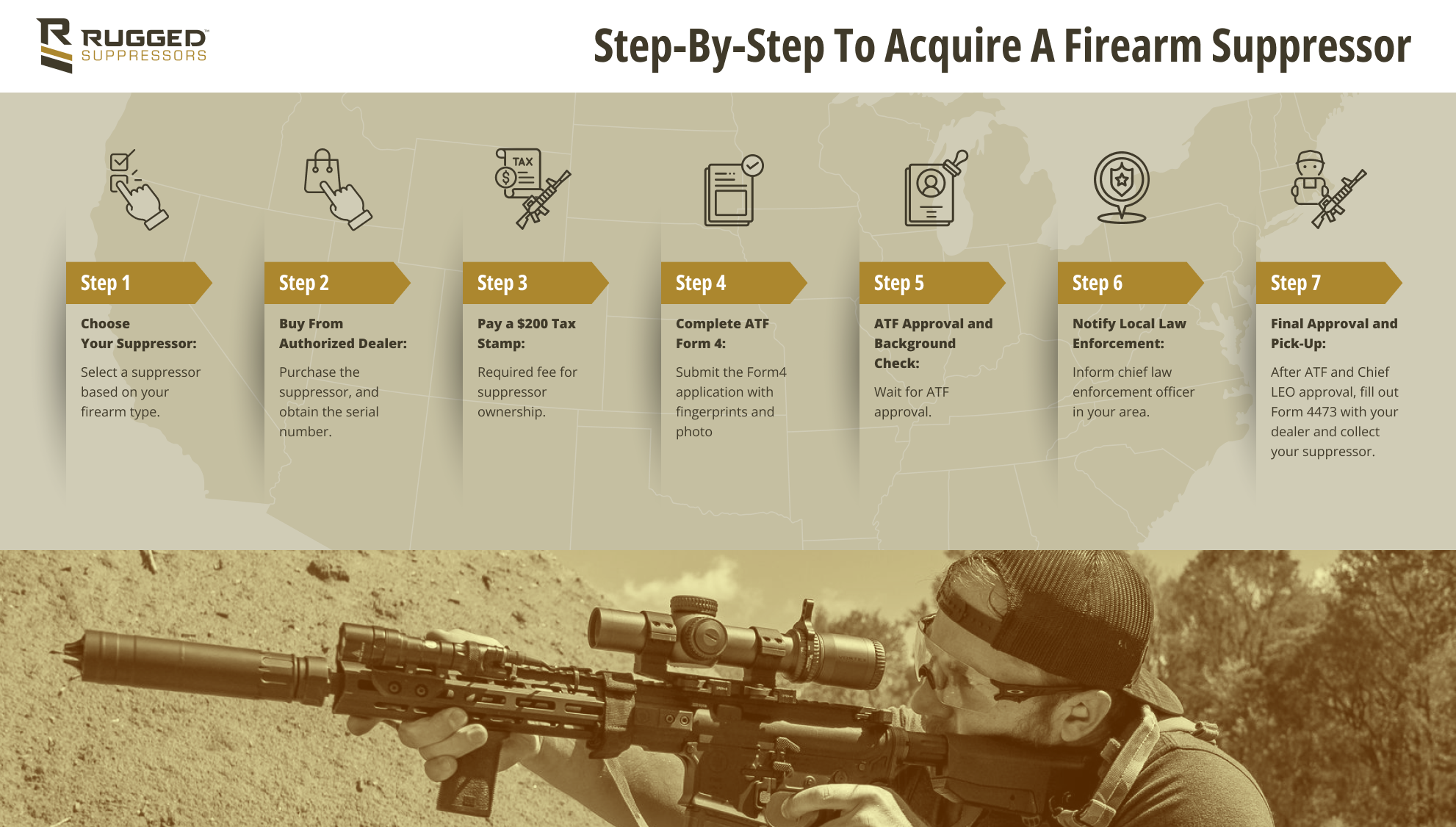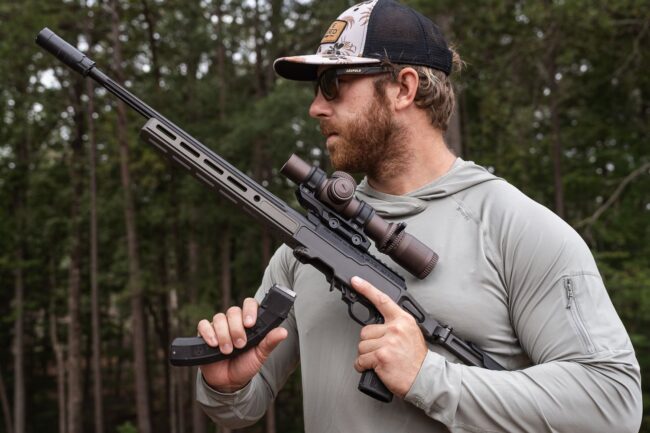Discover How to Buy a Suppressor and The Legal Requirements
The Importance of Firearm Suppressors
A suppressor, sometimes called a silencer, attaches to the muzzle of a firearm, reducing its audible signature. Suppressors are in much wider use today than they were just a decade ago. Once primarily the tool of special operators, many private citizens have seen the utility of suppressors. Suppressors effectively decrease the sound generated by your firearm, providing the advantage of preserving your hearing and averting the risk of hearing damage.
Suppressors also make conversation and communication much easier, ensuring enhanced safety during hunting expeditions. By dampening the noise associated with firing shots, suppressors protect your hearing and that of your hunting party, creating a safer environment for everyone involved. This noise reduction also minimizes disturbance to the surrounding wildlife, allowing for a more stealthy approach. Additionally, Rugged Suppressors are tested for accuracy and minimal point-of-impact shift, helping you maintain your position and stay on target for better follow-up shots. The benefits of using suppressors extend beyond hunting, as evidenced by the U.S. Marine Corps adoption of suppressors for large infantry units.
Suppressors are often misunderstood, but thanks to organizations like the American Suppressor Association (ASA), awareness of suppressors is growing. Rugged Suppressors is not only an innovative manufacturer of some of the best suppressors on Earth, but we are also heavily involved in suppressor advocacy. This article will cover what a suppressor is and does, including the entire process of how to purchase one, considering the ATF paperwork and compliance with the National Firearms Act.
Understanding Suppressors: The Basics
When a firearm discharges, be it a machine gun, short-barreled rifle, or any other legal entity under the National Firearms Act, two things cause noise. The first is the rapidly expanding gases. These gases are produced by the rapidly burning powder which forces the bullet down the barrel. This noise is called the muzzle blast. The other big source of noise is the supersonic crack of the bullet breaking the sound barrier. A suppressor can greatly reduce the muzzle blast, but can’t do much to prevent the supersonic crack. Let’s look at how that happens.
Suppressors work on a really simple principle: they slow escaping gases, reducing the muzzle blast and other signature sounds from the firearm. The suppressor is a tube that fits on the muzzle of the firearm, either by screwing directly on or via some sort of quick-attach direct thread adapter. When the gun is fired with a suppressor in place, the bullet travels straight through the suppressor and out. The gases that trail the bullet exit from the muzzle find themselves confined within a metal tube, a key component of the suppressor. Within this tube, you’ll encounter structures known as baffles, the number of which varies depending on the suppressor’s design. These baffles play a crucial role in slowing down the escaping gases and redirecting their path, effectively reducing the muzzle blast.
We’ve all seen fictional scenarios where suppressors are used in public spaces and no one in the crowd notices, but in reality, law enforcement and those with suppressor ownership understand that a suppressor will not make a gun “Hollywood quiet.” Remember we mentioned the supersonic crack? Even though a suppressor can significantly dampen muzzle blast, it won’t do much to help with the supersonic crack. The supersonic crack can be reduced by using ammunition moving slower than the speed of sound (around 1,100 feet per second), but this is a function of ammunition rather than a function of the suppressor itself. Suppressors and subsonic ammo do go together like peanut butter and jelly, though!
Another misconception is that suppressors reduce bullet velocity. This couldn’t be further from the truth. Suppressors actually increase the pressure inside the bore and almost universally have the effect of making bullets travel faster, not slower.
The market for firearm suppressors has never been stronger. There are more options, from more companies, than ever before. Rugged Suppressors offers a full line of suppressors for rifles, pistols/PCCs, and rimfire firearms, acknowledging the diverse needs to purchase a suppressor across the United States. Many of our cans are modular, too, meaning they can be reduced in length and weight for maximum mobility, or increased for maximum sound suppression.
The Legal Process of Acquiring a Suppressor

You’ve decided to purchase a suppressor, but how do you go about it? Suppressors are specially regulated NFA items that you can’t simply purchase across the counter like firearms or ammunition. They are regulated by the National Firearms Act of 1934, a legal entity governing such items. This law requires that potential owners submit a special application and pay a $200 tax stamp before being allowed to possess their suppressor.
The first step in owning a suppressor is choosing the one you want. This will be based largely on your host firearm – what gun are you trying to suppress? Once you have picked one out, you need to purchase it, initiating the entire process. It may sound strange to pay for something knowing you won’t touch it for several months (though you may be able to come visit it at the dealer’s shop!), but this is so a specific serial number, crucial for ATF approval, can be assigned to you. This serial number is then applied to the application that is submitted to the ATF.
We recommend purchasing your suppressor through an authorized Rugged Suppressors dealer. The dealer will be able to help you navigate some of the paperwork hassles. The first thing is Form4, the application to own a suppressor (or other NFA item) that is submitted to the ATF. It is officially called the “ATF Form 5320.4, Application for Tax Paid Transfer and Registration of Firearms.” Filling it out is not complicated. A signed copy of Form4, along with a copy of your fingerprints and a passport photo must then be submitted to the ATF for approval.
One thing you will likely hear mentioned is an NFA gun trust. A NFA trust is a legal instrument that you can set up to take ownership of your NFA items. There are a lot of benefits to putting suppressors in a trust, like facilitating suppressor ownership for family members. Since the trust technically owns the items, you can assign several responsible persons to the trust who can then use your suppressors. Trusts also make passing on NFA items after you die a much simpler process. The specifics are detailed and beyond the scope of this article but there are a lot of good reasons to use a gun trust.
Now begins your wait time. When your application comes up, they do a background check and process your $200 tax stamp. A letter is then sent to your chief LEO (this varies; it could be your local sheriff or the state attorney general), and they have seven days to respond.
After that additional, seven-day period is up, you can pick up your suppressor. You will have to go to the dealer and they will have you fill out ATF Form 4473, the form you fill out each time you buy a gun. Once that is done, they will hand you the suppressor and you can walk out the door. It feels a little strange the first time you are left with your new suppressor with no Big Brother supervision, but we promise – that’s it! It’s yours! Take it to the range and have fun!
Cost and Fees Associated with Buying a Suppressor

When purchasing a suppressor there are some costs to consider. The first is the cost of the suppressor itself. This will vary depending on what you want your suppressor to do. If you’re looking for a can for a .22, obviously it will be cheaper than a suppressor for a big-bore rifle. Building a bombproof suppressor that will handle .300 WinMag obviously requires more material, different material, and stronger manufacturing techniques than building a hard-use can for a .22 Long Rifle.
With Rugged Suppressors you get the best suppressors money can buy, which isn’t cheap. Made in America with the highest quality materials, our suppressors are durable and guaranteed to last a lifetime. Don’t believe us? We believe in our products so much that we back all of our suppressors with our Unconditional Lifetime Warranty to show you the reliability and pride we take in every suppressor we build.
After the cost of the suppressor itself, add another $200 for the tax stamp paid to Uncle Sam for the privilege of owning a suppressor. You may also be charged a small transfer free from the receiving dealer if you purchased the suppressor through an online retailer. There are also some hidden costs to suppressor ownership.
First, you will want more suppressors. Once you get over the intimidation factor and see how easy the process is, it will be hard not to buy another suppressor for another gun. Trust us, we’ve been there. Other costs, too, include things like muzzle adapters. You will want a flash hider or muzzle break that is compatible with your suppressor’s quick-detach system. If one suppressor is intended for many guns, you’ll want a muzzle device for each one. If you have a pistol suppressor you will need a Neilson device to make the pistol function with the can attached.
Beyond that, there’s not much hidden cost to owning a suppressor. Especially Rugged Suppressors that will essentially last a lifetime. Oh…except your ammo bill, which is going to go way up because shooting suppressed is fun beyond description!
Making the Purchase and Post-Purchase Considerations
Where should you purchase your Rugged Suppressor? We recommend buying it from an authorized dealer. You can search our website for brick-and-mortar, Class III dealer location. You can also purchase a Rugged Suppressor through SilencerShop.com. Silencer Shop kiosks are in a number of gun stores. The kiosk will guide you through a step-by-step process, take your fingerprints, your photo, and your signature. Regardless of where you buy your suppressor, buy a Rugged Suppressor. We are American-owned and American-operated. We stand behind our product, 100% with an Unconditional Lifetime Warranty. We proudly champion suppressor ownership and the loosening of restrictions on suppressors as a Tier 1 sponsor of the American Suppressor Association. And we build the best, toughest suppressors on the market.Check out our selection of Rifle Suppressors and Pistol Suppressors. Learn about what makes us different here: Why Rugged Suppressors.